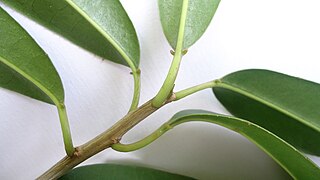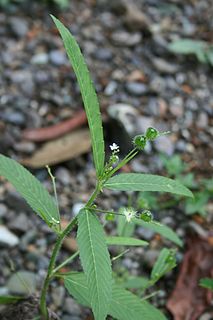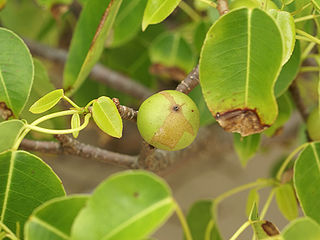
Sapium is a genus of flowering plants in the family Euphorbiaceae. It is widespread across most of Latin America and the West Indies. Many Old World species were formerly included in the genus, but recent authors have redistributed all the Old World species into other genera.

Pera is a genus of the flowering plant family Peraceae, first described as a genus in 1784. It is native to tropical America, from southern Mexico and the West Indies south as far as Paraguay.
Dysopsis is a genus of plants in the family Euphorbiaceae, first described in 1858. It is the sole genus in subtribe Dysopsidinae. The genus is native to Costa Rica, Panama, South America, and the Juan Fernández Islands.
- Dysopsis glechomoides(A.Rich.) Müll.Arg. - Chile, S Argentina
- Dysopsis hirsuta(Müll.Arg.) Skottsb. - Juan Fernández Islands
- Dysopsis paucidentata(Müll.Arg.) Lozano & J.Murillo - Costa Rica, Panama, Colombia, Venezuela, Ecuador, Peru, Bolivia
Conceveiba is a plant genus of the family Euphorbiaceae, first described as a genus in 1775. It is native to South America and Central America.
- Conceveiba guianensisAubl. - Brazil, Peru, Bolivia, Ecuador, Colombia, Venezuela, 3 Guianas
- Conceveiba hostmaniiBenth. - Guyana, Suriname, Amazonas State in Brazil
- Conceveiba krukoffiiSteyerm. - Venezuela, French Guiana, NW Brazil
- Conceveiba latifoliaBenth. - Colombia, Venezuela, Peru, Amazonas State in Brazil
- Conceveiba martianaBaill. - Venezuela, French Guiana, NW Brazil, Colombia, Ecuador, Peru, Bolivia
- Conceveiba maynasensisSecco - Loreto in Peru
- Conceveiba parvifoliaMcPherson - Panama, NW Colombia
- Conceveiba pleiostemonaDonn.Sm. - Costa Rica, Nicaragua, Colombia, Venezuela
- Conceveiba praealta(Croizat) Punt ex J.Murillo - NW Brazil
- Conceveiba ptariana(Steyerm.) Jabl. - S Venezuela
- Conceveiba rhytidocarpaMüll.Arg. - Colombia, Ecuador, Peru
- Conceveiba santanderensisJ.Murillo - NW Colombia
- Conceveiba terminalis(Baill.) Müll.Arg. - Venezuela, Guyana, Suriname, NW Brazil, Colombia, Peru
- Conceveiba tristigmataJ.Murillo - Colombia, Venezuela, NW Brazil
Adenophaedra is a plant genus of the family Euphorbiaceae first described as a genus in 1874. It is native to tropical regions of South America and Central America.
- Adenophaedra cearensis Secco - Ceará
- Adenophaedra grandifolia (Klotzsch) Müll.Arg. - Costa Rica, Panama, Colombia, Venezuela, Guyana, French Guiana, Ecuador, Peru, NW Brazil
- Adenophaedra megaphylla (Mull.Arg.) Mull.Arg. - Colombia, Ecuador, Peru, Suriname, E Brazil
Bernardia is a plant genus of the family Euphorbiaceae first described for modern science as a genus in 1754. It is native to North and South America, as well as the West Indies.

Alchorneopsis is a genus of flowering plants in the family Euphorbiaceae first described as a genus in 1865. It is native to Central America, the Greater Antilles, and northern South America.
- Alchorneopsis floribunda(Benth.) Müll.Arg. - Costa Rica, Honduras, Panama, Puerto Rico, Dominican Republic, 3 Guianas, Colombia, Venezuela, Ecuador, Peru, NW Brazil
- Alchorneopsis portoricensisUrb. - Puerto Rico
Caryodendron is a plant genus of the family Euphorbiaceae first described as a genus in 1860. The genus includes C. orinocense, known as the Inchi tree or Tacay nut. It is native to Central America and South America.
- Caryodendron amazonicumDucke - Amazonas in Brazil
- Caryodendron angustifoliumStandl. - Costa Rica, Panama, Colombia
- Caryodendron janeirenseMüll.Arg. - Rio de Janeiro
- Caryodendron orinocenseH.Karst - Colombia, Venezuela, Ecuador

Caperonia is a genus of plants of the family Euphorbiaceae first described as a genus in 1825. The genus is native to tropical and subtropical America and Africa.

Plukenetia is a genus of plant of the family Euphorbiaceae. It is widespread in tropical regions of Africa, the Indian Subcontinent, Southeast Asia, and the Americas.
Acidoton is a genus of plant of the family Euphorbiaceae first described as a genus in 1788. It is native to the Greater Antilles, Central America, and tropical South America.

Dalechampia is a genus of plant of the family Euphorbiaceae and of the monogeneric subtribe Dalechampiinae. It is widespread across lowland tropical areas primarily in the Americas with smaller numbers of species in Africa, Madagascar, and southern Asia. Additional new species are still being described and several are very rare and at risk of extinction.

Hippomane is a genus of plants in the Euphorbiaceae described by Linnaeus in 1753. It is native to the West Indies, Central America, Mexico, Florida, Venezuela, Colombia, and Galápagos.

Mabea is a plant genus of the family Euphorbiaceae first described in 1775. It is native to Central and South America as well as Mexico and Trinidad.
Astrocasia is a plant genus of the family Phyllanthaceae first described as a genus in 1905. It is included in the subtribe Astrocasiinae. It is native to Mesoamerica, northern South America, and the western part of the West Indies. Plants are mostly dioecious, except for Astrocasia diegoae which is monoecious, and some individuals of A. neurocarpa and A. tremula.
- Astrocasia austinii(Standl.) G.L.Webster - Izabal
- Astrocasia diegoaeJ.Jiménez Ram. & Mart.Gord. - Guerrero
- Astrocasia jacobinensis(Müll.Arg.) G.L.Webster - Bahia, Bolivia
- Astrocasia neurocarpa(Müll.Arg.) I.M.Johnst. ex Standl. - Oaxaca, Querétaro, San Luis Potosí, Tamaulipas
- Astrocasia peltataStandl. - Costa Rica, Nayarit, Jalisco
- Astrocasia tremula (Griseb.) G.L.Webster - Mexico, Central America, West Indies, northern South America

Dalechampia dioscoreifolia is a species of plant in the family Euphorbiaceae first described in 1841. It is native to Central America and northern and western South America.

Stenospermation is a genus of plant in family Araceae native to South America and Central America.
Aratitiyopea is a monotypic genus of flowering plants, in the family Xyridaceae containing the single species Aratitiyopea lopezii. The genus was erected and described in 1984. This species is native to northern South America.

Lacmellea is a genus of flowering plants in the family Apocynaceae first described as a genus in 1857. It is native to South America and Central America.
- Lacmellea abbreviataJ.F.Morales - Colombia
- Lacmellea aculeata(Ducke) Monach - Peru, NW Brazil, the Guianas
- Lacmellea arborescens(Müll.Arg.) Markgr. - Brazil, Bolivia
- Lacmellea bahiensisJ.F.Morales - Bahia
- Lacmellea costanensisSteyerm. - N Venezuela
- Lacmellea densifoliata(Ducke) Markgr. - Pará
- Lacmellea edulisH.Karst. - Panama, Venezuela, Colombia, Ecuador, Peru, Brazil
- Lacmellea floribunda(Poepp.) Benth. & Hook.f. - Peru, NW Brazil, Suriname, French Guiana
- Lacmellea foxii(Stapf) Markgr. - Peru
- Lacmellea gracilis(Müll.Arg.) Markgr. - N Peru, NW Brazil
- Lacmellea guyanensis(Müll.Arg.) Monach - French Guiana
- Lacmellea klugiiMonach. - Peru
- Lacmellea macranthaJ.F.Morales - Ecuador
- Lacmellea microcarpa(Müll.Arg.) Markgr. - Colombia, S Venezuela, NW Brazil
- Lacmellea oblongataMarkgr. - SE Colombia, Ecuador, Peru
- Lacmellea panamensis(Woodson) Markgr. - Costa Rica, Panama, Colombia, Ecuador
- Lacmellea pauciflora(Kuhlm.) Markgr. - Brazil
- Lacmellea peruviana(Van Heurck & Müll.Arg.) Markgr. - Peru
- Lacmellea pygmaeaMonach. - Amazonas State in Venezuela
- Lacmellea ramosissima(Müll.Arg.) Markgr. - Colombia, S Venezuela, NW Brazil
- Lacmellea speciosaWoodson - Costa Rica, Panama, Colombia, Ecuador, Peru
- Lacmellea standleyi(Woodson) Monach. - Belize, Guatemala, Honduras
- Lacmellea utilis(Arn.) Markgr. - S Venezuela, Guyana
- Lacmellea zamoraeJ.F.Morales - Costa Rica

Pausandra is a plant genus of the family Euphorbiaceae first described in 1870. It is native to Central America and South America.
- Pausandra fordiiSecco - Amapá, French Guiana
- Pausandra hirsutaLanj. - Peru, Brazil, Bolivia (Pando), Colombia (Amazonas)
- Pausandra macropetalaDucke - Brazil, Peru (Loreto), Venezuela (Amazonas)
- Pausandra macrostachyaDucke - Pará
- Pausandra martiniBaill. - French Guiana, Suriname, Guyana, Colombia, Venezuela, Peru, Brazil
- Pausandra megalophyllaMüll.Arg. - Rio de Janeiro
- Pausandra morisiana(Casar.) Radlk. - Brazil
- Pausandra trianae(Müll.Arg.) Baill. - widespread from Honduras to Bolivia











